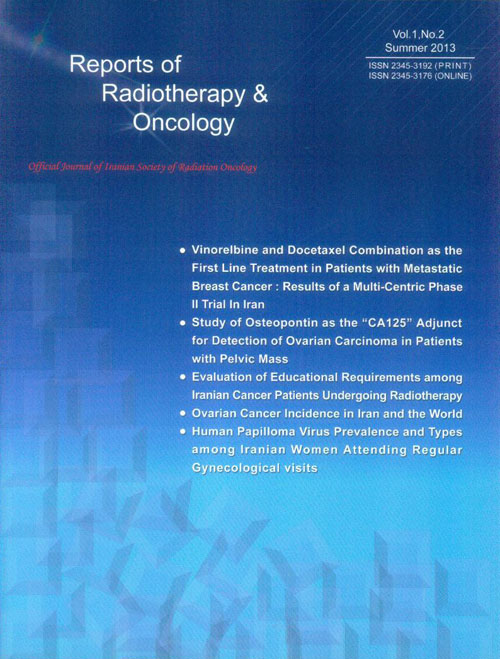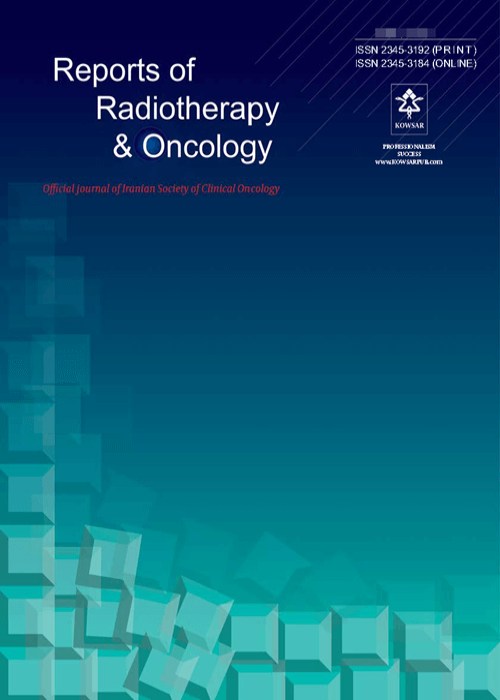فهرست مطالب

Reports of Radiotherapy and Oncology
Volume:1 Issue: 2, Sep 2013
- تاریخ انتشار: 1393/07/17
- تعداد عناوین: 7
-
-
Page 51IntroductionWe conducted a multi-centric phase II study to evaluate the tumor response and safety of the combination of vinorelbin and docetaxel in treatment of metastatic breast cancer patients. Patients andMethodsForty one metastatic breast cancer patients, who had at least one measurable lesion and had not been treated for metastasis before, were enrolled from March 2006 to June 2009. Treatment contained vinorelbine 25mg/m2 [Click and drag to move] [Click and drag to move] IV and docetaxel 30mg/m2 [Click and drag to move] [Click and drag to move] at day 1 and 8. Cycles were repeated every 21 days for 6 cycles. We evaluated response to chemotherapy every three weeks and toxicity every week.ResultsThe mean age of patients was 50.4 years (range 30-81). Twenty eight patients (68.2%) had received prior neoadjuvant anthracycline based chemotherapy. No patient had received adjuvant chemotherapy within the last 3 months. Twenty four patients (58.3%) had two or more metastatic sites. Thirty six patients were evaluable for their response. An objective tumor response (either complete response or partial response) was achieved in 32 (88.8%) and complete response was seen in 9 (25%) patients. Thirteen patients (31.6%) developed grade 3-4 neutropenia and neutropenic fever was reported in 11 (26.8%). Grade 3 anemia was observed in 1 patient (2.4%). No grade 4 non-hematological toxicity was noted and the most frequent grade 3 non-hematological toxicities were hair loss (39%), stomatitis (7.3%) and diarrhea (4.8%). Median time to progression was 7 months and median overall survival was 11 months.ConclusionVinorelbine-docetaxel combination shows a considerable tumor response and manageable toxicity as the first line treatment for metastatic breast cancer. It seems logical to conduct phase III trials to further evaluate this regimen.Keywords: Metastatic breast cancer, chemotherapy, vinorelbine, docetaxel
-
Page 65IntroductionCancer is the 3rd cause of death after heart disease and injuries in Iran. Radiotherapy is one of the most effective procedures in cancer therapy, but in spite of widespread usage, its nature and side effects are still unknown for many patients. The main goal of this survey was studying various educational needs among cancer patients with specific emphasis on radiation therapy and its side effects.Material And MethodsThis study was a descriptive-analytical research based on information extracted from personal interviews and files in order to determinate patients’ educational needs and their relationship with different variables such as demographic characteristics and the kind of disease among those referred to radiation therapy department in Mashhad Omid Hospital during a 6 months period.ResultsOur findings show that age and marital status have a statistically significant association with educational needs (P<0.01). Also patients in early stage of their disease had higher educational requirements. Most of the patients had limited or moderate information about their disease and treatment effects (88%). In addition 46% of patients mentioned the physician as their preferred source of information.ConclusionOur findings indicate lack of training about oncologic treatment and its side effects among our cancer patients, and emphasizes the need for a structured program to alleviate this problem. It seems that the role of physicians in this field is more significant than other health care staff.Keywords: Cancer, radiation therapy, education, physician, Iran
-
Page 69IntroductionOvarian cancer ranks the 8th cancer causing death in the world. This study aims to compare incidence rate of ovarian cancer in Iran with other countries.Materials And MethodsData from International Agency for Research on Cancer’s GLOBOCAN 2008 database is used to compare ovarian cancer age standard incidence rate from different parts of the globe considering the developing and developed regions.ResultsIran is among countries with low incidence of ovarian cancer and an age standard incidence rate of 3.07 in 2005 and 3.1 in 2008.ConclusionsOvarian cancer is the most common gynecologic cancer in Iran. Various risk and protective factors of ovarian cancer might be clarified in Iran in order to prevent increasing incidence of this cancer in the future. At the present this disease is significant considering its disease burdenKeywords: Ovarian cancer, incidence, disease, burden, Iran
-
Page 73IntroductionHuman papilloma virus prevalence data is scarce in Iran. This study was performed to evaluate type-specific human papilloma virus prevalence and to compare it with Pap smear results among Iranian women attending regular gynecological visits.Patients andMethodsA total of 851 women aged 18-65 years, attending regular gynecological visits were retrospectively evaluated. Human papilloma virus detection and genotyping was performed using polymerase chain reaction technique. Cytological evaluation was performed by Papanicolaou method and the association between cytological results and human papilloma virus profile was analyzed.ResultsNineteen different types of human papilloma virus were detected in 265 of 851 patients (31.1%). Overall infection as well as infection with high risk human papilloma virus types; were highest in women aged 18-25 years and decreased with age. Type-specific prevalence of human papilloma virus -16 and 18 was 7.3% and 2.8% respectively. There was also an upward trend in the prevalence of high risk human papilloma virus infection as the abnormality in cytology increased. The prevalence of human papilloma virus related events was 29.1% among virus positive patients and declined from low grade squamous intraepithelial lesion (18.2%) to high grade squamous intraepithelial lesion (3.9%).Keywords: Human papilloma virus, prevalence, type, Iran
-
Page 81IntroductionDrug-induced vasculitis following chemotherapy has been rarely reported. We report such a case of drug-induced vasculitis following chemotherapy in a breast cancer patient. Report of the case: A 52 year old woman with stage III breast cancer developed pathologically proven vasculitis presenting as bilateral severe erythema, edema and ulceration on both feet 10 days following the 4th cycle of adjuvant chemotherapy. Chemotherapy consisted of docetaxel, doxorubicin, and cyclophosphamide in each cycle that was preceded by premedication including dexamethasone, granisetron, and H1 and H2 blockers. Furthermore, filgrastim (5µg/kg) was administered following each cycle of chemotherapy during days 5-9. By discontinuing chemotherapy and starting high-dose intravenous methylprednisolone, vasculitis was resolved. The patient did not experience vasculitis following the re-challenge of chemotherapy excluding docetaxel and filgrastim.ConclusionThis case suggests that docetaxel and filgrastim might be added to the list of agents causing drug-induced vasculitis.Keywords: Drug, induced, vasculitis, docetaxel, filgrastim, breast cancer


